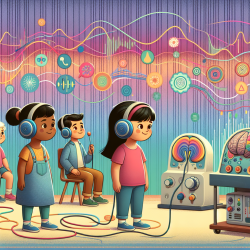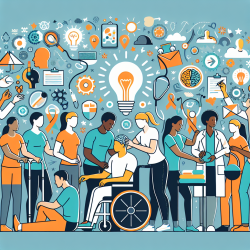Introduction
The development of effective communication skills in children hinges on a well-functioning auditory system. As such, understanding the auditory processing capabilities of children is crucial for speech-language pathologists and audiologists. The study "Effects of Age and Type of Stimulus on the Cortical Auditory Evoked Potential in Healthy Malaysian Children" provides valuable insights into how age and stimulus type influence cortical auditory evoked potentials (CAEP) in children. This blog will explore the study's findings and discuss how practitioners can apply these insights to improve clinical outcomes.
Study Overview
The study involved 35 healthy Malaysian children aged 4 to 12 years. Researchers recorded CAEP waveforms using a 1 kHz tone burst and the speech syllable /ba/. They analyzed the latencies and amplitudes of the P1, N1, and P2 peaks to determine the effects of age and stimulus type on CAEP waveforms.
Key Findings
- Significant negative correlations were found between age and speech-evoked CAEP latency for each peak, indicating that CAEP latencies shorten with age when using speech stimuli.
- No significant correlations were found between age and tone-evoked CAEP amplitudes and latencies.
- The speech syllable /ba/ produced a higher mean P1 amplitude than the 1 kHz tone burst.
Implications for Practitioners
The findings suggest that speech stimuli may be more effective than tone bursts in eliciting CAEP responses that reflect auditory processing maturation in children. This has several implications for clinical practice:
- Early Intervention: Shorter CAEP latencies in older children highlight the importance of early auditory assessments and interventions. Practitioners should consider incorporating speech stimuli in evaluations to better understand auditory processing development.
- Stimulus Selection: Given the higher P1 amplitudes elicited by speech stimuli, practitioners might prefer speech syllables over tone bursts when assessing auditory processing in children.
- Normative Data: The study provides preliminary normative CAEP data for Malaysian children, which can be used as a reference in clinical assessments.
Encouragement for Further Research
While the study provides valuable insights, further research with larger sample sizes is recommended to validate these findings. Future studies could explore the sensitivity and specificity of CAEP in diagnosing auditory disorders in children and compare normative data with hearing-impaired children using hearing aids or cochlear implants.
Conclusion
The study underscores the importance of considering age and stimulus type in auditory assessments. By integrating these findings into practice, speech-language pathologists and audiologists can enhance their diagnostic accuracy and improve outcomes for children with auditory processing challenges.
To read the original research paper, please follow this link: Effects of Age and Type of Stimulus on the Cortical Auditory Evoked Potential in Healthy Malaysian Children.










